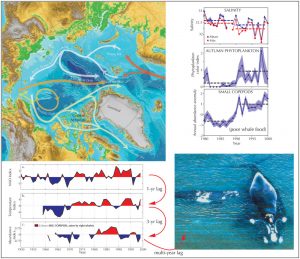Marine Climate Change

The oceans interact with climate drivers in manifold ways that range from obvious to subtle. This largest water bath stores heat and dampens temperature swings. Oceans also dissolve, store and cycle radiatively active gases such as carbon dioxide, thereby reducing their greenhouse effects. Dissolution of anthropogenic carbon dioxide in the sea causes ocean acidification. The chain of chemical events driven by acidification makes carbontate, needed by many organisms to make shells and other support structures more difficult to obtain. The hydrogen ion then associates with a carbonate ion to form another bicarbonate ion, thereby making carbonate, needed to form shells and hard parts of organisms from microscopic phytoplankton to clams and lobsters, more difficult to obtain. The problem can be exacerbated by multiple stressors such as acidification, warming and metal shortage. Algae in the oceans take up carbon dioxide and use it to synthesize organic matter. Marine physical and biogeochemical processes determine whether the cells produced will decompose in surface waters and return to the atmosphere quickly as carbon dioxide, whether they will sink to deep waters and return carbon dioxide on time scales of ocean overturn or be buried for geological time (millions of years). Burial in marine sediments is the only major exit route for carbon from the active biosphere. SMS scientists also study how turbulence enchances phytoplankton nutrient uptake. Enhanced stratification from global warming is expected to decrease average turbulence intensities but to raise turbulence intensities locally and episodically in more violent weather events. If you are interested in the ways that climate change influences the ocean and in the ways that the ocean influences climate change, be sure to visit the interactive COSEE-OS website.
Participating Faculty
-

-

-

-

Heather Leslie, Ph.D.
Professor of Marine Sciences
207.563.8115
-

-

-

-

-

-

